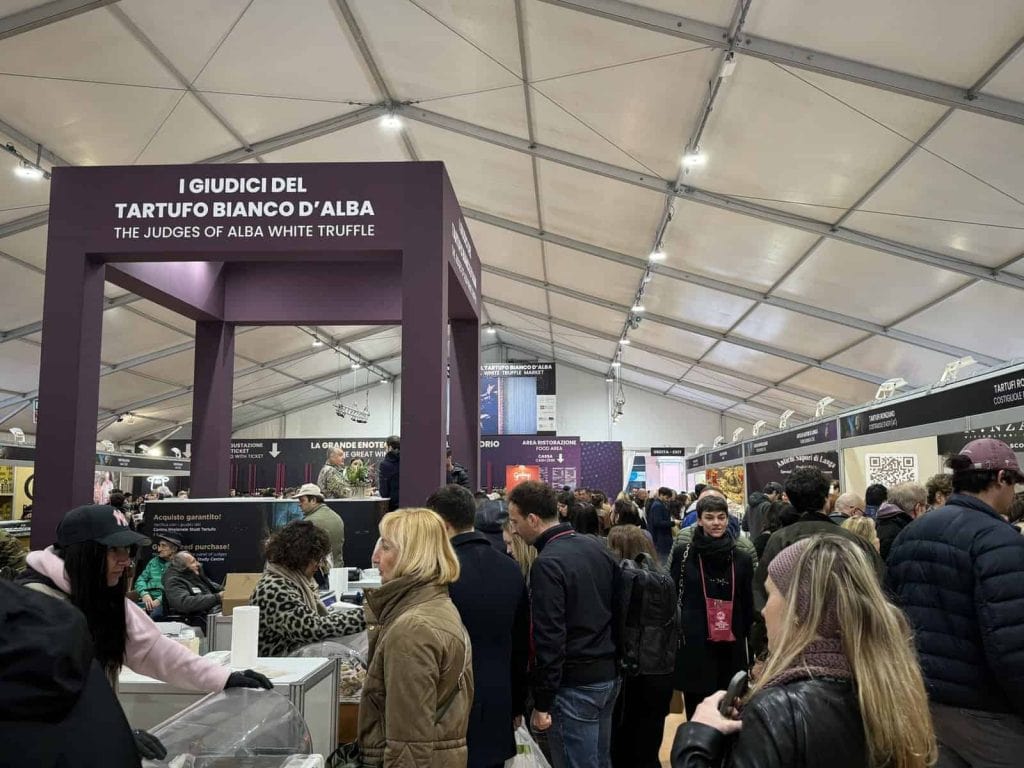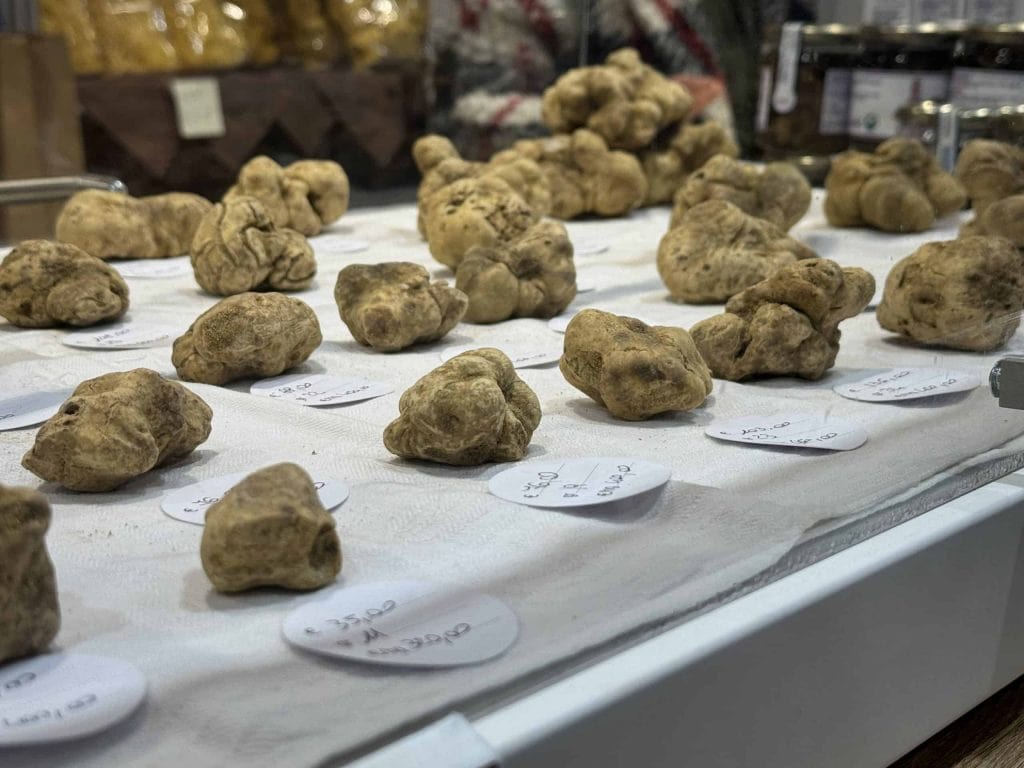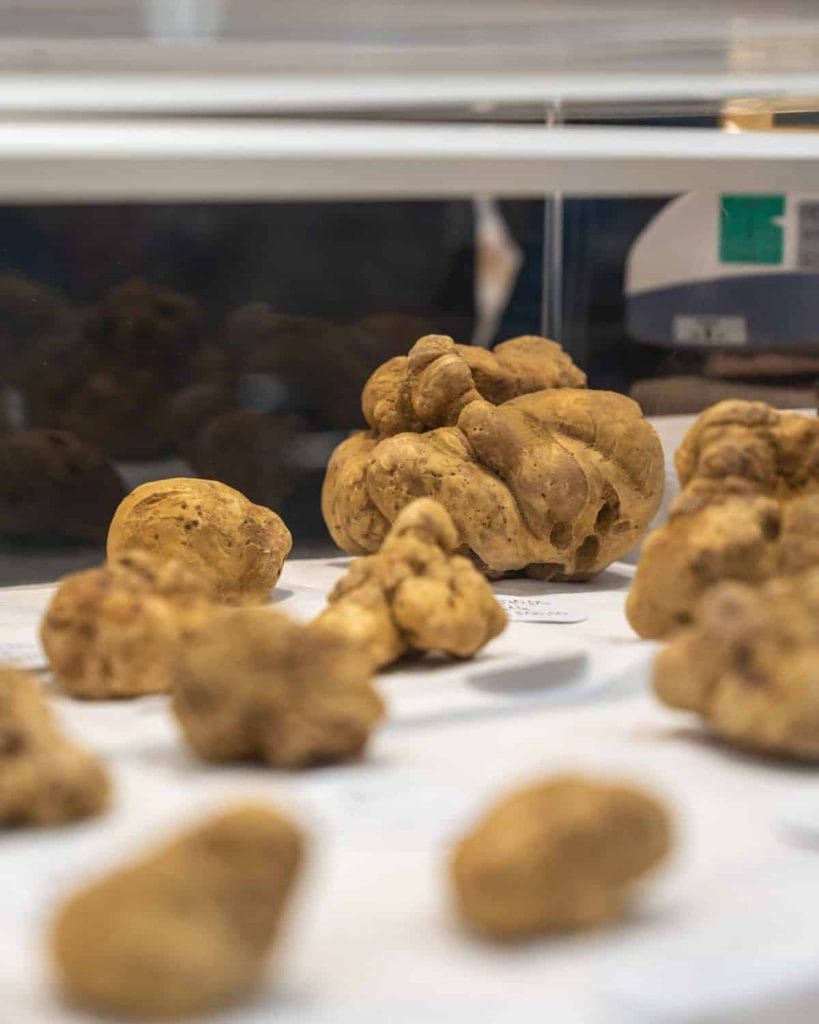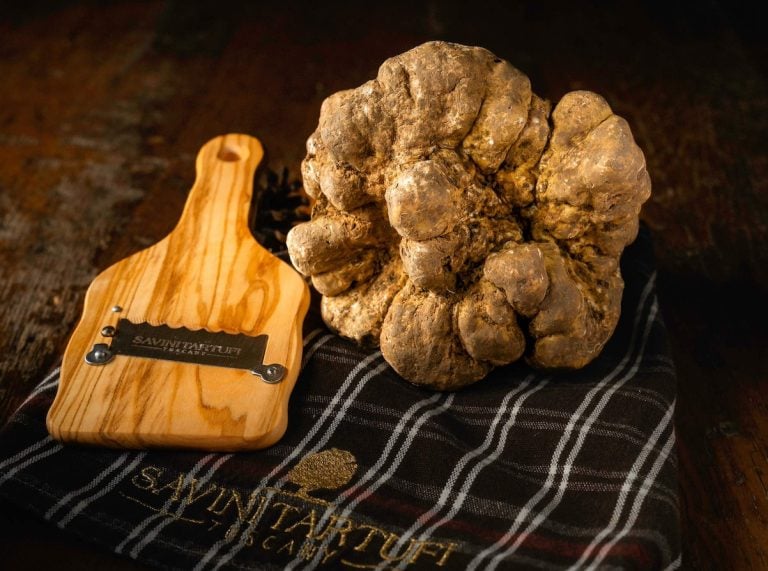“White gold is raining down.” This metaphor comes to mind almost automatically when you see the Alba White Truffle (Tuber magnatum pico) shaved over risotto, tagliolini, or even an egg. This isn’t just a reference to the price of this prized edible ascomycete fungus, but also to its significance as a territorial treasure of Piedmont, considered among the finest in the world. But how do you choose a truffle? What characteristics should you look for, and, more importantly, how do you store it properly? I found the answers at the Alba International White Truffle Fair, where this product is celebrated, explained, elevated, and, of course, sold.

The fair for Alba’s diamond
Now in its 94th edition, the fair was initiated by Giacomo Morra in 1929. “A visionary who became, almost unintentionally, the first marketer of the Alba White Truffle, despite being just a hotelier,” says Stefano Cometti, a judge of sensory analysis of truffles. “He elevated this fair through the gifts he sent around the world. He gifted truffles to various figures, including U.S. presidents and even Marilyn Monroe. It was his way of showcasing a product with unique organoleptic characteristics that can only be found here.”
Distinctive features
“We’re currently experiencing a boom in the quality of Alba White Truffles, thanks to the rains in August,” explains Cometti. “It takes about three months for the truffle’s fruiting body (sporocarp) to develop, and this period allowed it to form perfectly along with its typical aromatic profile.” The 2024 season has been particularly fortunate, with abundant rains yielding especially aromatic specimens.
But what are the key traits of this truffle variety?
“The Alba White Truffle is defined by sensory analysis, a scientific method that catalogues and describes the visual, olfactory, and tactile characteristics of truffles,” Cometti explains. “Its unique olfactory marker comes from sulfur ions in the soil, giving it a spicy sensation reminiscent of garlic. Initially, there’s a distinct aroma of fresh garlic, but it should never be overpowering. This is softened by a sweet hint of linden or acacia flowers, honey, and finishes with a constant trail of fresh mushroom—like freshly sliced porcini or champignon.”

Buying Tips
The price? For the 2024 season, it ranges between €3,500 and €4,000 per kilogram, depending on size. But how should one select a truffle when making a small gastronomic investment?
“One of the best ways is to buy it at the fair. Here, truffles are individually inspected, and those that don’t meet sensory analysis criteria cannot be sold. Generally, I advise everyone to trust their nose, avoiding aromas that feel familiar or ‘safe,’ like cheese or dairy, as these are not characteristic of truffles. Instead, seek the distinctive notes of this variety: garlic, honey, and mushroom.”
Visual appeal
After passing the olfactory test, there’s the visual exam. Does consistency and shape affect the flavour? Should you choose round and smooth or lumpy and irregular?
“Consistency is important. It should be firm, not rubbery or soft. Currently, the texture rates 9 on the sensory analysis scale, meaning it has incredible density. As for shape, whether it’s flat, round, or irregular, there’s not much difference in quality. A round truffle, however, is about 10% more expensive due to its aesthetic appeal. When I showcase truffles on TV, I display a round one because it’s like a beautiful pearl in a jewel box. Qualitatively, though, they’re all excellent.”

Does size matter?
Choosing how much to spend also determines the size of the truffle. It might seem logical to think that larger (and thus more expensive) truffles are better, but the reality is different—fortunately.
“For larger truffles, I’m thinking about weights from half a kilo to a kilo. However, these aren’t necessarily as good because they tend to mature unevenly due to their biological-vegetative development process. An ideal size is around 20 grams or more. In fact, 20 grams is perfect for two people and can be easily enjoyed in one sitting.”
Usage guidelines
There are only a few rules for using truffles. First of all, they must be shaved with a proper truffle slicer.
“Do not use empirical methods or alternatives like knives or potato peelers. Truffle slicers start at €15, a cost anyone can afford, and at that price, you can find ones that last a lifetime.” Beyond the theatrical gesture, slicing truffles into thin slivers over a dish at serving time serves a specific purpose.
“White truffle should not be cooked or heated. Unlike black truffle, which is grated with a microplane and can be heated in butter for pasta or eggs, white truffle functions like a tea strainer when sliced. The thin slices allow steam particles from the dish to pass through, releasing the truffle’s full aroma profile.”
Is black or white truffle better?
“It depends on how you plan to use it and the aromatic profile you’re seeking. Black truffles have exclusively fresh mushroom aromas. In fine black truffles, there may be nuances of vanilla, cocoa, or saffron.”
A short-lived luxury
Once purchased, it’s crucial not to treat it like a relic or worse, immerse it in rice.
“Rice is hygroscopic, meaning it absorbs moisture from the truffle. Storing truffles in rice results in fragrant rice but a dried-out truffle that becomes essentially a ‘piece of cork.’ Truffles should be individually wrapped in a paper towel, stored in an airtight container, and kept at a temperature of 4 to 6 degrees for a few days. The wrapping should be changed daily as the paper tends to become moist. However, in my opinion, the best way to preserve a truffle is to eat it and cherish the memory.”


 US tariffs: here are the Italian wines most at risk, from Pinot Grigio to Chianti Classico
US tariffs: here are the Italian wines most at risk, from Pinot Grigio to Chianti Classico "With U.S. tariffs, buffalo mozzarella will cost almost double. We're ruined." The outburst of an Italian chef in Miami
"With U.S. tariffs, buffalo mozzarella will cost almost double. We're ruined." The outburst of an Italian chef in Miami "With US tariffs, extremely high risk for Italian wine: strike deals with buyers immediately to absorb extra costs." UIV’s proposal
"With US tariffs, extremely high risk for Italian wine: strike deals with buyers immediately to absorb extra costs." UIV’s proposal Meloni: "Tariffs? If necessary, there will be consequences. Heavy impact on agri-food sector"
Meloni: "Tariffs? If necessary, there will be consequences. Heavy impact on agri-food sector" The Government honours the greats of Italian cuisine, from Bottura to Pepe. Massari: "Thank you, Meloni, the only one who listened to us"
The Government honours the greats of Italian cuisine, from Bottura to Pepe. Massari: "Thank you, Meloni, the only one who listened to us"






